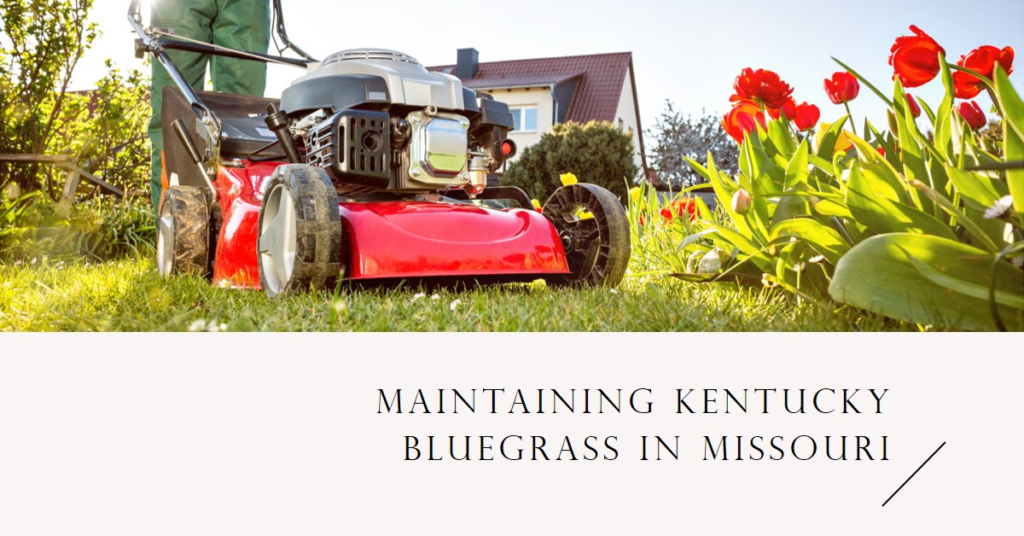Introduction
Kentucky Bluegrass is a renowned selection for lawns in Missouri owing to its resistance to heat and drought. This warm-season grass flourishes in the climate of the state; but demands adequate and consistent attention to remain healthy and visually pleasing. This discourse will steer you through a meticulous 12-month procedure to maintain your Kentucky Bluegrass in Missouri. We shall furnish you with details about the amount to apply every month and the frequency of application.
January: Dormancy and Monitoring
- Kentucky Bluegrass is dormant in winter, so avoid fertilizing or heavy watering during January.
- Instead, focus on monitoring your lawn for pests, diseases, or frost damage.
- Address any issues promptly to prevent further damage.
February: Pre-Emergent Herbicide
- In February, mow your lawn to remove any dead or brown grass and help stimulate new growth
- Avoid fertilizing at this stage, but you can apply a pre-emergent herbicide like Scotts Halts Crabgrass & Grassy Weed Preventer to prevent weed germination. For more about preventing weeds, click here.
- Generally, you’ll need to apply 2.5 to 3.5 pounds of the product per 1,000 square feet of lawn area, depending on the targeted weeds and the strength of the formulation. Use a broadcast spreader to evenly distribute the granules across the entire lawn. It’s essential to water the lawn after application, as this will help activate the herbicide and move it into the soil.
March: Spring Fertilization and Aeration
- As temperatures begin to rise in March, apply a balanced slow-release fertilizer like Scotts Turf Builder Lawn Food. Follow the package instructions for application, typically applying 1 pound of nitrogen per 1,000 square feet.
- For Scotts Turf Builder, apply about 3.125 pounds of product per 1,000 square foot. To learn more about different fertilizers, including N-P-K values click here.
- Aerate your lawn in March to improve soil structure and all water, air, and nutrients to penetrate the grass roots.
- Rent a core aerator from The Home Depot and run it over your lawn. Check out our article about aeriation.
April: Watering and Mowing
- In April, water your Kentucky Bluegrass deeply and infrequently (1 inch of water per week).
- Avoid overwatering, which can lead to shallow roots and increased susceptibility to pests and diseases.
- Mow your lawn weekly, setting your mower’s cutting height to 1.5-2 inches. Make sure to remove no more than one-third of the grass blade’s length at a time.
May: Pest Control and Maintenance
- Monitor your lawn for pests like chinch bugs and grubs.
- Treat with Ortho BugClear Insect Killer if needed.
- Continue with regular mowing and watering schedule.
June: Summer Fertilization and Weed Control
- Apply a second round of fertilizer in June.
- For Scotts Turf Builder, apply about 3 pounds of product per 1,000 square foot. To learn more about different fertilizers, including N-P-K values click here.
- Monitor your lawn for the presence of weeds and treat them accordingly. Treat broadleaf weeds with Ortho WeedClear Lawn Weed Killer.
July: Watering and Mowing Adjustments
- Due to high temperatures in July, adjust your watering schedule (1-1.5 inches of water per week).
- Raise your mower’s cutting height slightly to help your lawn retain moisture and prevent heat stress.
August: Lawn Repair and Disease Control
- In August, repair damaged areas with Kentucky Bluegrass plugs or sod.
- Make sure to water new grass consistently to help it establish roots.
- Treat lawn diseases with Scotts DiseaseEx Lawn Fungicide or BioAdvanced Fungus Control for Lawns.
September: Fall Fertilization and Overseeding
- In September, apply a third round of fertilizer.
- Overseed thin or patchy areas with Kentucky Bluegrass seed.
October: Preparing for Winter Dormancy
- As the temperatures begin to drop in October, gradually reduce the frequency of watering.
- Continue mowing as needed, but avoid cutting too short, as this can stress the grass and make it more susceptible to frost damage.
November: Final Mowing and Winterization
- In November, conduct your final mowing, cutting slightly shorter than usual.
- Clear any fallen leaves or debris from your lawn to improve air circulation and prevent fungal growth.
- Although Kentucky Bluegrass does not typically require winterizer fertilizer applications, if you feel that your lawn needs additional support, you can apply a high potassium content fertilizer to help strengthen your grass’s root system and enhance its cold tolerance.
December: Winter Maintenance and Monitoring
- During December, your Kentucky Bluegrass will be mostly dormant.
- Minimize foot traffic on your dormant lawn.
- Monitor for frost damage or diseases and address any issues promptly.
Note: Always read and follow the label instructions for each product
Share this post: on Twitter on Facebook
